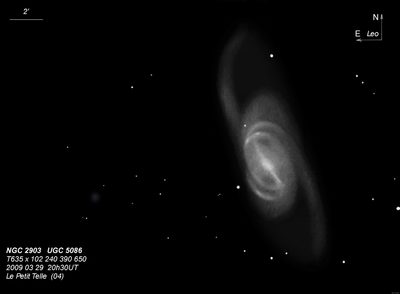
William Herschel discovered NGC 2903 = H I-56 = h604.I on 16 Nov 1784 (sweep 318) and recorded "cB, cL, a small bright spot in the middle; at first sight appears very much elongated, but by careful attention it appears to consist of two; the nf of which less bright than the sp, though nearly of the same size and shape with the former, it has also a brightish spot in the middle but not nearly so brilliant as the other; dist of the center about a minute." John Herschel recorded on sweep 244, "I. 56 is vB; E; gbM; r[esolvable]. Long attentions shows a vF, L, R, neb attached n f." NGC 2905 = h604.II is the "neb attached n f" and refers to the northeast spiral arm (or a brighter region in the spiral arm).
Lord Rosse first observed this galaxy on 24 Mar 1846 and noted "a tendency to an annular or spiral arrangement discovered." He commented the night was bad, though. NGC 2903 was probably the second galaxy (after M51) in which spiral structure was noted. On 9 Mar 1848 Romney Robinson, director of Armagh Observatory and a regular observer at Birr Castle, commented "Night excellent, a spiral seen in an oblique direction, resolved well, particularly towards the vB centre." LdR was a bit more conservative in his assessment of spiral structure and didn't include this galaxy in his table of 16 spirals in the 1850 Philosophical Transactions paper, though a published sketch from 5 Mar 1848 shows multiple spiral arms with a knot embedded NGC 2905). Dreyer later commented, "the engraving does not agree with the numerous sketches taken later..."
William Lassell published three different sketches of NGC 2903 made in 1862 with his 48-inch on Malta. (plate II, Fig. 12). They all showed a "wavy" or curved body with "hooks" at the ends of the spiral arms.
200/250mm - 8" bright, large, elongated, bright mottled core.
300/350mm - 13.1" (12/22/84): very bright, elongated bright core. Contains a very faint knot at the north end = NGC 2905.
400/500mm - 17.5" (1/31/87): this is one of the brightest non-Messier galaxies. Very bright and large, elongated 5:2 SSW-NNE, 10'x4'. A very faint knot is involved on the NNE side 1.2' from center = NGC 2905. An extremely faint knot is also symmetrically placed opposite the core on the SW end 1.2' from center. The galaxy has a dusty, mottled appearance with knots and arcs easily visible with averted vision.
17.5" (3/23/85): a second knotty region is definitely visible on the SW edge. Lord Rosse mentions these two knots as "thickened regions".
600/800mm - 24" (2/22/14): excellent view at 200x and 375x. This beautiful barred spiral is sharply concentrated with an extremely bright, mottled core. A prominent central bar runs along the major axis, extending ~2'x0.4' SSW-NNE. The central bar is the brightest portion of an more oval, brighter central region, ~2.0'x1.0'. Just beyond the northeast end of the central bar is a bright, irregular "knot" (NGC 2905) where the northern spiral arm attaches. This arm bends sharply to the west (clockwise), but only curves for ~1' and quickly fades, as if it was angled towards us. A prominent arm (more cleanly separated from the central region) is attached at the south-southwest end of the bar where there is another brighter, irregular "knot". The southern arm bends east and then north, paralleling the orientation of the bar and extending as far north as the core, perhaps just beyond a mag 13.7 star 2' ESE of center. A darker dust lane separates this arm from the central region.
900/1200mm - 48" (4/18/15): this superb spiral was observed at 375x. Several luminous patches were visible along the central bar, which trends SSW-NNE, including a patch (NGC 2905) at the northeast end near the beginning of the western spiral arm. Another patch is at the south end of the core with a third near the southern end of the bar where the outer eastern arm emanates. The outer western arm extends south for a length of ~4', just beyond the southern edge of the main body. The outer eastern arm emerges from the south end of the galaxy, curls east and shoots north. Although the surface brightness becomes quite low, the arm extends well beyond the main body for a total length of ~7'! At the northern end is a low surface brightness larger patch about 5.5' NE of center. The tips of the spiral arms are over 9' apart.
Notes by Steve Gottlieb